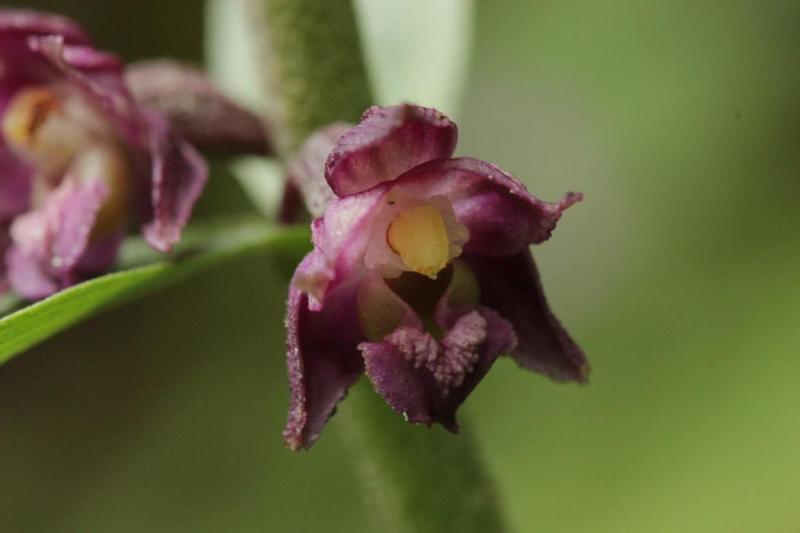Epipactis atrorubens
Also known as: The Black or Serapias sylvestris Helleborine atropurpurea lusus viridiflora Epipactis rubiginosa lusus viridiflora Epipactis latifolia ssp. leptochila Epipactis latifolia ssp. clunensis Epipactis cruenta Epipactis atrorubens var. dilatata Epipactis atrorubens var. macedonica Helleborine atropurpurea var. dilatata Epipactis danubialis Epipactis media Amesia atropurpurea Amesia rubiginosa Epipactis macropodia Epipactis thessala Epipactis subclausa Epipactis spiridonovii Limodorum rubiginosum Helleborine viridans Epipactis atrorubens var. stenopetala Helleborine atropurpurea lusus lutescens Epipactis atrorubens ssp. subclausa Epipactis atrorubens subvar. suboppositifolia Epipactis atrorubens ssp. spiridonovii Epipactis viridans Helleborine atropurpurea f. suboppositifolia Helleborine atropurpurea f. radnensis Helleborine atropurpurea f. orbicularis Epipactis atrorubens f. orbicularis Helleborine atropurpurea f. leviconica Helleborine atropurpurea f. latifolia Epipactis atrorubens f. sirneensis Epipactis atrorubens f. majoriflora Helleborine atropurpurea f. borbasii Helleborine atropurpurea Helleborine atropurpurea f. alternifolia Helleborine atropurpurea lusus pallens Epipactis latifolia subvar. lutescens Epipactis atrorubens subvar. borbasii Epipactis rubiginosa Epipactis atrorubens var. atrata Epipactis atrorubens ssp. triploidea Helleborine rubiginosa Epipactis atrorubens var. triploidea Epipactis helleborine var. viridans Epipactis atropurpurea subvar. virescens Epipactis atrorubens ssp. borbasii Epipactis atropurpurea f. pallens Epipactis atrorubens f. angustifolia Epipactis atropurpurea var. majoriflora Epipactis persica ssp. danubialis Epipactis atropurpurea subvar. lutescens Epipactis atropurpurea var. longibracteata Epipactis latifolia var. atrorubens Epipactis atropurpurea var. leviconica Epipactis latifolia Epipactis helleborine var. rubiginosa Epipactis atropurpurea Epipactis latifolia var. minor Epipactis latifolia f. viridans Epipactis atrorubens subvar. albiflora Epipactis atrorubens subvar. lutescens Epipactis helleborine ssp. viridans Epipactis atrorubens subvar. radnensis Epipactis atrorubens f. longibracteata Epipactis atrorubens f. latifolia Helleborine media Epipactis latifolia var. rubiginosa Epipactis latifolia var. viridans Epipactis atrorubens f. pallens Epipactis atrorubens ssp. danubialis Epipactis atrorubens subvar. viridiflora Epipactis rubiginosa f. latifolia Epipactis atrorubens var. media Epipactis rubiginosa var. orbicularis The Broad-Leaved Helleborine in the subfamily: Epidendroideae
Native to: Austria Belgium Bulgaria Denmark Finland France Germany Greece Hungary Ireland Italy Netherlands Norway Poland Romania Spain Sweden Switzerland Ukraine
General Information
The Black is a large cold to cool growing terrestrial orchid belonging to the sub family Epidendroideae native to Austria, Belgium, Bulgaria, Denmark, Finland, France, Germany, Greece, Hungary, Ireland, Italy, Netherlands, Norway, Poland, Romania, Spain, Sweden, Switzerland, and Ukraine.
Plant Description
Each new growth has numerous lance shaped leaves
Flowers
Numerous fragrant blossoms appear during Summer and Spring
Fragrance
The orchid is fragrant.
Blooming Season
- Spring
- Summer
Care Notes
These orchids grow on the forest floor so are used to rich soil containing plenty of organic matter that is always moist (but not always wet), and prefer constant conditions in terms of humidity, temperature and water supply. They may not be as forgiving as epiphytes in regards to sudden changes in growing conditions so it is wise to ease them into new conditions over a the space of a few days, and repot as infrequently as possible.
Keep an eye on the plants condition regularly as they can decline suddenly if the conditions are not just right. It is more important to keep water supply constant rather than frequent - overwatering often causes rot which can quickly set in, especially in warmer conditions.
These can be grown in shady, moist areas in the garden, supplied they have protection from abrupt changes caused by the elements, e.g. dry winds, frost etc. Being grown around companion plants such as ferns and bromeliads will help build and retain the humidity they require throughout the year.
Fragrant:- IsFragrant
Fertiliser
These plants do well with slow release fertiliser at the rate of 2-3 pellets per cup (250ml) of media. Additional fertiliser during the growth period may be beneficial, but not necessary.
Potting
These plants can be sensitive to repotting though should not require repotting regularly. Repotting should be done when the mix has broken down to the point that it doesn't absorb water or holds onto water for far too long, usually the plant shows a decline in growth as well.
The mix should be free draining, with a blend of 30% inorganic ingredients such as coarse sand, gravel or perlite, mixed in with about 70% organic ingredients such as peat, leaf litter or decomposed bark. Avoid commercial potting mixes as they can vary wildly and may contain "wetting agents" that can hold onto water for loo long, causing rotting and stunted growth.





















